 |
| June 02, 2015 | Volume 11 Issue 21 |
Mechanical News & Products
Designfax weekly eMagazine
Archives
Partners
Manufacturing Center
Product Spotlight
Modern Applications News
Metalworking Ideas For
Today's Job Shops
Tooling and Production
Strategies for large
metalworking plants
hyperMILL 2024 CAD/CAM software suite
 OPEN MIND Technologies has introduced its latest hyperMILL 2024 CAD/CAM software suite, which includes a range of powerful enhancements to its core toolpath capabilities, as well as new functionality for increased NC programming efficiency in applications ranging from 2.5D machining to 5-axis milling. New and enhanced capabilities include: Optimized Deep Hole Drilling, a new algorithm for 3- and 5-axis Rest Machining, an enhanced path layout for the 3D Plane Machining cycle, better error detection, and much more.
OPEN MIND Technologies has introduced its latest hyperMILL 2024 CAD/CAM software suite, which includes a range of powerful enhancements to its core toolpath capabilities, as well as new functionality for increased NC programming efficiency in applications ranging from 2.5D machining to 5-axis milling. New and enhanced capabilities include: Optimized Deep Hole Drilling, a new algorithm for 3- and 5-axis Rest Machining, an enhanced path layout for the 3D Plane Machining cycle, better error detection, and much more.
Learn more.
One-part epoxy changes from red to clear under UV
 Master Bond UV15RCL is a low-viscosity, cationic-type UV-curing system with a special color-changing feature. The red material changes to clear once exposed to UV light, indicating that there is UV light access across the adhesive material. Although this change in color from red to clear does not indicate a full cure, it does confirm that the UV light has reached the polymer. This epoxy is an excellent electrical insulator. UV15RCL adheres well to metals, glass, ceramics, and many plastics, including acrylics and polycarbonates.
Master Bond UV15RCL is a low-viscosity, cationic-type UV-curing system with a special color-changing feature. The red material changes to clear once exposed to UV light, indicating that there is UV light access across the adhesive material. Although this change in color from red to clear does not indicate a full cure, it does confirm that the UV light has reached the polymer. This epoxy is an excellent electrical insulator. UV15RCL adheres well to metals, glass, ceramics, and many plastics, including acrylics and polycarbonates.
Learn more.
SPIROL Press-N-Lok™ Pin for plastic housings
 The Press-N-Lok™ Pin was designed to permanently retain two plastic components to each other. As the pin is inserted, the plastic backfills into the area around the two opposing barbs, resulting in maximum retention. Assembly time is quicker, and it requires lower assembly equipment costs compared to screws and adhesives -- just Press-N-Lok™!
The Press-N-Lok™ Pin was designed to permanently retain two plastic components to each other. As the pin is inserted, the plastic backfills into the area around the two opposing barbs, resulting in maximum retention. Assembly time is quicker, and it requires lower assembly equipment costs compared to screws and adhesives -- just Press-N-Lok™!
Learn more about the new Press-N-Lok™ Pin.
Why hybrid bearings are becoming the new industry standard
 A combination of steel outer and inner rings with ceramic balls or rollers is giving hybrid bearings unique properties, making them suitable for use in a wide range of modern applications. SKF hybrid bearings make use of silicon nitride (twice as hard as bearing steel) rolling elements and are available as ball bearings, cylindrical roller bearings, and in custom designs. From electric erosion prevention to friction reduction and extended maintenance intervals, learn all about next-gen hybrid bearings.
A combination of steel outer and inner rings with ceramic balls or rollers is giving hybrid bearings unique properties, making them suitable for use in a wide range of modern applications. SKF hybrid bearings make use of silicon nitride (twice as hard as bearing steel) rolling elements and are available as ball bearings, cylindrical roller bearings, and in custom designs. From electric erosion prevention to friction reduction and extended maintenance intervals, learn all about next-gen hybrid bearings.
Read the SKF technical article.
3M and Ansys train engineers on simulating adhesives
 Ansys and 3M have created an advanced simulation training program enabling engineers to enhance the design and sustainability of their products when using tapes and adhesives as part of the design. Simulation enables engineers to validate engineering decisions when analyzing advanced polymeric materials -- especially when bonding components made of different materials. Understand the behavior of adhesives under real-world conditions for accurate modeling and design.
Ansys and 3M have created an advanced simulation training program enabling engineers to enhance the design and sustainability of their products when using tapes and adhesives as part of the design. Simulation enables engineers to validate engineering decisions when analyzing advanced polymeric materials -- especially when bonding components made of different materials. Understand the behavior of adhesives under real-world conditions for accurate modeling and design.
Read this informative Ansys blog.
New FATH T-slotted rail components in black from AutomationDirect
 Automation-Direct has added a wide assortment of black-colored FATH T-slotted hardware components to match their SureFrame black anodized T-slotted rails, including: cube connectors (2D and 3D) and angle connectors, joining plates of many types, brackets, and pivot joints. Also included are foot consoles, linear bearings in silver and black, cam lever brakes, and L-handle brakes. FATH T-slotted hardware components are easy to install, allow for numerous T-slotted structure configurations, and have a 1-year warranty against defects.
Automation-Direct has added a wide assortment of black-colored FATH T-slotted hardware components to match their SureFrame black anodized T-slotted rails, including: cube connectors (2D and 3D) and angle connectors, joining plates of many types, brackets, and pivot joints. Also included are foot consoles, linear bearings in silver and black, cam lever brakes, and L-handle brakes. FATH T-slotted hardware components are easy to install, allow for numerous T-slotted structure configurations, and have a 1-year warranty against defects.
Learn more.
Weird stuff: Moon dust simulant for 3D printing
 Crafted from a lunar regolith simulant, Basalt Moon Dust Filamet™ (not a typo) available from The Virtual Foundry closely mirrors the makeup of lunar regolith found in mare regions of the Moon. It enables users with standard fused filament fabrication (FFF) 3D printers to print with unparalleled realism. Try out your ideas before you go for that big space contract, or help your kid get an A on that special science project.
Crafted from a lunar regolith simulant, Basalt Moon Dust Filamet™ (not a typo) available from The Virtual Foundry closely mirrors the makeup of lunar regolith found in mare regions of the Moon. It enables users with standard fused filament fabrication (FFF) 3D printers to print with unparalleled realism. Try out your ideas before you go for that big space contract, or help your kid get an A on that special science project.
Learn more.
Break the mold with custom injection molding by Rogan
 With 90 years of industry experience, Rogan Corporation possesses the expertise to deliver custom injection molding solutions that set businesses apart. As a low-cost, high-volume solution, injection molding is the most widely used plastics manufacturing process. Rogan processes include single-shot, two-shot, overmolding, and assembly. Elevate your parts with secondary operations: drilling and tapping, hot stamping, special finishes, punch press, gluing, painting, and more.
With 90 years of industry experience, Rogan Corporation possesses the expertise to deliver custom injection molding solutions that set businesses apart. As a low-cost, high-volume solution, injection molding is the most widely used plastics manufacturing process. Rogan processes include single-shot, two-shot, overmolding, and assembly. Elevate your parts with secondary operations: drilling and tapping, hot stamping, special finishes, punch press, gluing, painting, and more.
Learn more.
World's first current-carrying fastening technology
 PEM® eConnect™ current-carrying pins from Penn-Engineering provide superior electrical connections in applications that demand high performance from internal components, such as automotive electronics. This first-to-market tech provides repeatable, consistent electrical joints and superior installation unmatched by traditional fastening methods. Features include quick and secure automated installation, no hot spots or poor conductivity, and captivation options that include self-clinching and broaching styles.
PEM® eConnect™ current-carrying pins from Penn-Engineering provide superior electrical connections in applications that demand high performance from internal components, such as automotive electronics. This first-to-market tech provides repeatable, consistent electrical joints and superior installation unmatched by traditional fastening methods. Features include quick and secure automated installation, no hot spots or poor conductivity, and captivation options that include self-clinching and broaching styles.
Learn more about eConnect pins.
New interactive digital catalog from EXAIR
 EXAIR's latest catalog offers readers an incredible source of innovative solutions for common industrial problems like conveying, cooling, cleaning, blowoff, drying, coating, and static buildup. This fully digital and interactive version of Catalog 35 is designed for easy browsing and added accessibility. Customers can view, download, print, and save either the full catalog or specific pages and sections. EXAIR products are designed to conserve compressed air and increase personnel safety in the process. Loaded with useful information.
EXAIR's latest catalog offers readers an incredible source of innovative solutions for common industrial problems like conveying, cooling, cleaning, blowoff, drying, coating, and static buildup. This fully digital and interactive version of Catalog 35 is designed for easy browsing and added accessibility. Customers can view, download, print, and save either the full catalog or specific pages and sections. EXAIR products are designed to conserve compressed air and increase personnel safety in the process. Loaded with useful information.
Check out EXAIR's online catalog.
5 cost-saving design tips for CNC machining
 Make sure your parts meet expectations the first time around. Xometry's director of application engineering, Greg Paulsen, presents five expert tips for cutting costs when designing custom CNC machined parts. This video covers corners and radii, designing for deep pockets, thread depths, thin walls, and more. Always excellent info from Paulsen at Xometry.
Make sure your parts meet expectations the first time around. Xometry's director of application engineering, Greg Paulsen, presents five expert tips for cutting costs when designing custom CNC machined parts. This video covers corners and radii, designing for deep pockets, thread depths, thin walls, and more. Always excellent info from Paulsen at Xometry.
View the video.
What can you secure with a retaining ring? 20 examples
 From the watch dial on your wrist to a wind turbine, no application is too small or too big for a Smalley retaining ring to secure. Light to heavy-duty loads? Carbon steel to exotic materials? No problem. See how retaining rings are used in slip clutches, bike locks, hip replacements, and even the Louvre Pyramid.
From the watch dial on your wrist to a wind turbine, no application is too small or too big for a Smalley retaining ring to secure. Light to heavy-duty loads? Carbon steel to exotic materials? No problem. See how retaining rings are used in slip clutches, bike locks, hip replacements, and even the Louvre Pyramid.
See the Smalley design applications.
Load fasteners with integrated RFID
 A crane, rope, or chain may be required when something needs lifting -- plus anchoring points on the load. JW Winco offers a wide range of solutions to fasten the load securely, including: lifting eye bolts and rings (with or without rotation), eye rings with ball bearings, threaded lifting pins, shackles, lifting points for welding, and more. Some, such as the GN 581 Safety Swivel Lifting Eye Bolts, even have integrated RFID tags to clearly identify specific lifting points during wear and safety inspections and manage them digitally and without system interruption.
A crane, rope, or chain may be required when something needs lifting -- plus anchoring points on the load. JW Winco offers a wide range of solutions to fasten the load securely, including: lifting eye bolts and rings (with or without rotation), eye rings with ball bearings, threaded lifting pins, shackles, lifting points for welding, and more. Some, such as the GN 581 Safety Swivel Lifting Eye Bolts, even have integrated RFID tags to clearly identify specific lifting points during wear and safety inspections and manage them digitally and without system interruption.
Learn more.
Couplings solve misalignments more precisely with targeted center designs
 ALS Couplings from Miki Pulley feature a simplistic, three-piece construction and are available in three different types for more precisely handling parallel, angular, or axial misalignment applications. The key feature of this coupling design is its center element. Each of the three models has a center member that has a unique and durable material and shape. Also called a "spider," the center is designed to address and resolve the type of misalignment targeted. Ideal for unidirectional continuous movement or rapid bidirectional motion.
ALS Couplings from Miki Pulley feature a simplistic, three-piece construction and are available in three different types for more precisely handling parallel, angular, or axial misalignment applications. The key feature of this coupling design is its center element. Each of the three models has a center member that has a unique and durable material and shape. Also called a "spider," the center is designed to address and resolve the type of misalignment targeted. Ideal for unidirectional continuous movement or rapid bidirectional motion.
Learn more.
What is 3D-MID? Molded parts with integrated electronics from HARTING
 3D-MID (three-dimensional mechatronic integrated devices) technology combines electronic and mechanical functionalities into a single, 3D component. It replaces the traditional printed circuit board and opens up many new opportunities. It takes injection-molded parts and uses laser-direct structuring to etch areas of conductor structures, which are filled with a copper plating process to create very precise electronic circuits. HARTING, the technology's developer, says it's "Like a PCB, but 3D." Tons of possibilities.
3D-MID (three-dimensional mechatronic integrated devices) technology combines electronic and mechanical functionalities into a single, 3D component. It replaces the traditional printed circuit board and opens up many new opportunities. It takes injection-molded parts and uses laser-direct structuring to etch areas of conductor structures, which are filled with a copper plating process to create very precise electronic circuits. HARTING, the technology's developer, says it's "Like a PCB, but 3D." Tons of possibilities.
View the video.
Engineers develop ballistic wallpaper, pop-up guard towers, laser guns for military
By David Vergun, U.S. Army
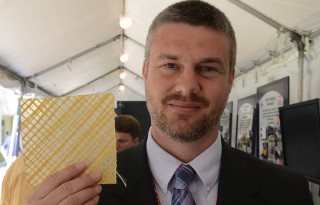
Nick Boone, a research mechanical engineer with the U.S. Army Corps of Engineers' Engineer Research and Development Center, in Vicksburg, MS, shows a section of ballistic wallpaper during DOD Lab Day at the Pentagon May 14, 2015. [Photo Credit: David Vergun]
Troops often use abandoned masonry, brick, or cinderblock structures for defensive purposes instead of building their own or digging foxholes.
While these structures offer a degree of protection, they are susceptible to blast impact from missile or other large projectiles, said Nick Boone, a research mechanical engineer with the U.S. Army Corps of Engineers' Engineer Research and Development Center, or ERDC, in Vicksburg, MS.
Boone spoke during DOD Lab Day at the Pentagon May 14, where a large number of Army laboratory exhibits were on display.
Engineers at ERDC came up with a novel idea of fortifying these structures with rolls of lightweight ballistic wallpaper with adhesive backing that can quickly be put up on the inside of the walls, he said.
The wallpaper consists of Kevlar fiber threads embedded in flexible polymer film, he said.
Without the wallpaper, a wall that is hit will "rubblize," he said, sending shards of rock and mortar flying at the occupants inside.
When the blast occurs with the wallpaper installed, it acts as a "catcher's net," containing the rubble and preventing debris from injuring Soldiers.
Engineers built unreinforced structures and actually bombed and blasted them, Boone said, showing a video of the experiments. Small blast testing was done at nearby Fort Polk, LA, and large-blast testing was conducted at Eglin Air Force Base, FL.
Ballistic wallpaper is still in the research and development stage and does not yet have an official name, but it could one day be produced and fielded and hopefully save lives, Boone said.
Other protection
Improved protection mortar pits and guard towers, designed by engineers at ERDC and royal engineers from the United Kingdom, have recently been shipped to Afghanistan, Boone said.
ERDC engineers developed the Modular Protective System, or MPS. These are inexpensive, lightweight, easily assembled and disassembled panels attached by cross-braces, which offer "a lot of protection," he said. The panels were developed by ERDC, and the cross-braces were developed with collaboration from the royal engineers.
"We got the idea from picnic chairs that fold up neatly," he said.
The structures are pretty basic, he said. The braces are made of lightweight galvanized steel tubing, and the panels are made of multi-layered fiberglass.
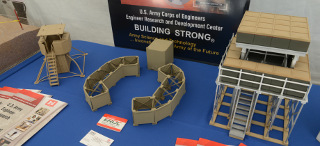
Modular Protective System models of guard towers and mortar pit protection are shown during DOD Lab Day at the Pentagon May 14, 2015. [Photo Credit: David Vergun]
Boone showed models of the fortification as well as full-size versions. They resembled scaffolding. The steel tubing is crossed-braced at angles that afford the greatest strength, he said. It is strong enough to protect against military-grade rounds.
Besides being inexpensive, strong, and lightweight, the MPS can be quickly assembled by just a few Soldiers without any specialized tools or equipment, he said.
Another positive is that the entire MPS structure fits inside a small container that can be sling-loaded under a CH-47 Chinook helicopter for rapid delivery, he said. The beauty of it is that the shipping container itself then becomes the ammunition storage for the mortar pit structure. For the guard tower, the shipping container becomes a platform to support it.
Once the mission ends, everything gets packed back into the shipping container. Nothing gets wasted or left behind, he said.
The mortar pit MPS kits are being used by Soldiers of the 82nd Airborne Division in Afghanistan, he said. The guard towers are being used by the royal engineers there as well. A small, expeditionary guard tower for the U.S. Army has not yet been deployed.
MPS is standing by for licensing and for a possible transition to a program of record, he said.
Contaminants protection
While protection from blast is fairly evident, protection from the unseen can be just as deadly.
Dr. Brandon Lafferty, a research soil scientist with ERDC, said that while operating in enemy territory, Soldiers sometimes come across existing infrastructure that poses threats that cannot be seen.
"Sometimes, those buildings were abandoned for a reason," Lafferty said. "They may have been a chemical processing site, a waste dump, we just don't know. There are currently no portable tools to rapidly determine possible hazards."
Soldiers on the move often do not have time to wait for heavy test equipment to be trucked in and tested by specialists, he continued.
ERDC engineers developed the "Environmental Toolkit for Expeditionary Operations" to address this problem, he said.
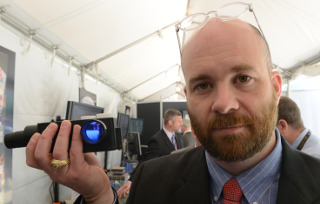
Dr. Brandon Lafferty shows the Petroleum Environmental Test Kit during DOD Lab Day at the Pentagon May 14, 2015. [Photo Credit: David Vergun]
An engineer, who is not a specialist, can toss all the instruments he needs in his rucksack and determine if contaminants are present and what their levels of concentration are, he said, so that a commander can make an informed decision whether or not to occupy the structures or area.
The three pieces of gear used for testing include the Hand-held Fluorescent Spectrometer, which measures heavy metals in soil and water; the Petroleum Environmental Test Kit, which identifies and measures petroleum content in soil and water; and the Water Dog, which tests water properties for hardness, acidity, conductivity, and turbidity to determine if the water is contaminated, good for drinking, or maybe just clean enough for washing clothing.
When Soldiers decamp, the area is tested once more because of environmental reporting that requires an area to be left uncontaminated, he said.
Soldiers are being trained to use the test equipment at the Maneuver Support Center of Excellence on Fort Leonard Wood, MO. Test equipment is now being field tested in Kuwait and Iraq, he said.
Video teleconference in a suitcase
When Soldiers need to set up an outpost or bivouac in an unfamiliar area, there might be hazards nearby like landslides or flooding that they're not aware of.
To determine if the location is safe, Soldiers can contact the experts at ERDC who have all of that information readily available, said Vernon Lowery, general engineer, ERDC.
To make contact in remote areas possible, ERDC has supplied the entire Army with Telecommunications Equipment Deployable, or TCED. This video teleconferencing capability comes in a small suitcase that is easily carried by one person, he said. The communications equipment links to Vicksburg via satellite.
Soldiers in remote areas might also want to communicate with people other than at ERDC for various reasons. Lowery said ERDC can relay them to Video Teleconferences, or VTCs, elsewhere around the world.
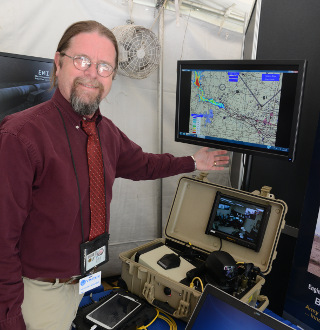
Vernon Lowery, general engineer, ERDC, shows the telecommunications equipment deployable during DOD Lab Day at the Pentagon May 14, 2015. [Photo Credit: David Vergun]
For example, when Soldiers deployed to Haiti to assist with earthquake humanitarian assistance relief in 2010, they used TCED to establish command and control. Lowery said Soldiers told him it was their "lifeline," and without it, they could not have accomplished their mission.
Laser protection
Laser guns may sound like the stuff of science fiction, but engineers at the U.S. Army Space and Missile Defense Command - Technical Center at Redstone Arsenal, AL, have successfully developed and tested just such a system, known as High Energy Laser Mobile Demonstrator, or HEL MD.
Dee Formby, an engineer involved in its development, said that a 10-kW laser, mounted on a Heavy Expanded Mobility Tactical Truck A4 platform, successfully took out 60-mm mortars and unmanned aerial vehicles at White Sands Missile Range, NM, last year.
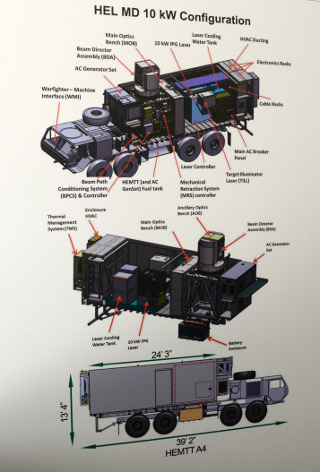
Workings of the High Energy Laser Mobile Demonstrator are shown during DOD Lab Day at the Pentagon May 14, 2015. [Photo Credit: David Vergun]
Once the laser locks on, it essentially fries its target, Formby said. It is a cost-effective way to destroy cruise missiles, unmanned aerial vehicles, mortars, rockets, and artillery.
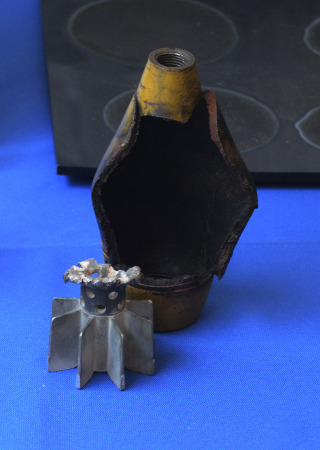
A 60-mm mortar round fried open by a High Energy Laser Mobile Demonstrator during testing is shown during DOD Lab Day at the Pentagon May 14, 2015. [Photo Credit: David Vergun]
In good weather, the laser achieves a high success rate, he said. Right now, the system does not perform as well in degraded weather and atmospheric conditions. Distance-to-target remains classified.
In 2017, a 50-kW version will be tested, followed by a 100-kW demonstration in 2020. Higher power means quicker kill time of the projectile, he said, because more power is on the target.
Published 2015
Rate this article
View our terms of use and privacy policy


